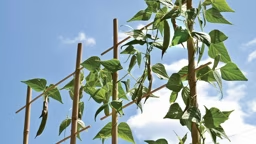
No matter if the square footage of your log or timber home falls in the quaint category or teeters toward grand, chances are you want it to feel like a sanctuary, perfectly nestled into the landscape and offering a sense of respite and relaxation. But what if you’re near a road or a bit too close to the neighbors? It might feel a little less private than you’d like.
To create a more secluded space, fencing is the obvious option, but you’d usually need quite a bit of height and width for that endeavor, and that runs the risk of making your cabin and surrounding landscape go from cozy to cramped. Fortunately, there are plenty of plants that can create a natural border without blocking you in. Keep these living-fence essentials in mind:
Dimensions
Do you need more height or more width (or both) in the space you’re trying to fill? Shrubs like juniper or sky pencil holly can expand into a space well but won’t grow above 10 feet, so if you’re trying to block the sight of a neighbor’s second story, it may not be the ideal option. In that case, opt for height, which usually means trees such as pines or arborvitae, both of which offer tapered coverage that’s also lacy, filtering light and sight lines.
Design
Whether to plant the same type of tree (or shrub) in a row or mix it up is a matter of preference. The first approach offers a uniform, maintained appearance — for example, a stretch of conical cypress trees can be very pretty and create tons of privacy — while the second option, to mix it up, can make a landscape seem less “planned.” For that, consider a blend of different heights, such as laurel trees alongside lilacs, bordered by slower-growing boxwoods.
Carolina Jessamine
Photo by thongchainak - stock.adobe.com
Use on Structures
If you already have some fencing in place but it doesn’t provide as much coverage as you’d like, that’s a great opportunity to use some climbing plants (like those pictured above) that will add charm as well as discretion. Carolina Jessamine (a non-invasive alternative to English ivy), climbing roses, clematis or even grapevines all offer visual appeal, while softening the harsh lines of a hardscape wall or traditional fencing.
Growing Time
There’s a reason why many people choose to make a larger investment in planting mature trees rather than put in smaller options that will take years to fill in. If privacy is only a minor consideration and you don’t mind waiting a decade for a tree to reach its full height, a younger plant is likely a more affordable option. But if you want to establish your border sooner, it makes more sense to plant a few fully grown trees now.
A good rule of thumb to keep in mind is that most trees and shrubs appropriate for a living fence (e.g., pines, firs, Norway spruce and magnolias, among others) grow about one to two feet per year. Getting a head start can help you achieve privacy faster, while still maintaining a charming, natural look to your property.















